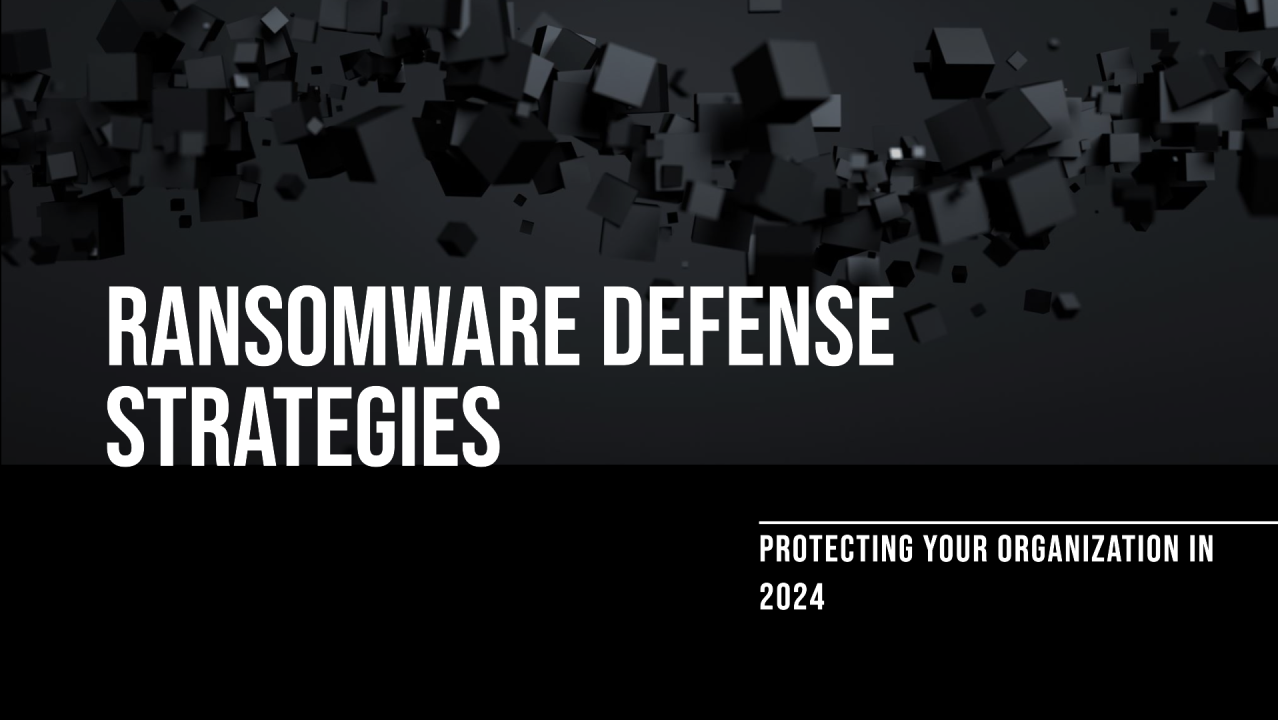Ransomware Defense: Effective Strategies for 2024
Ransomware attacks are a growing threat, where hackers take control of your data and demand payment to release it. In 2024, it’s more important than ever to know how to defend against ransomware. Below, you’ll find key strategies that can help protect you from these cyber threats.
Regular Data Backups: Your First Line of Defense
Backing up your data is one of the most effective ways to protect yourself from ransomware. When hackers lock your files and demand payment, having a backup means you don’t need to give in to their demands. You can simply restore your files from a safe copy.
To do this effectively, make sure your backup is kept in a secure location, like an external hard drive or cloud storage that isn’t connected to your main network. This keeps the backup safe even if your main system gets infected. Regularly update your backups, so your data is always current. Schedule automatic backups to ensure this process happens without you needing to remember.
In 2024, using cloud storage for backups is becoming increasingly popular. Cloud services often offer secure encryption, protecting your data while it’s stored. Make sure the cloud provider you choose has strong security measures in place.
Finally, regularly test your backups to ensure they work. There’s no point in backing up your data if you can’t recover it when needed. Many people forget this step, but it’s crucial for a reliable defense.
Up-to-Date Security Software: Keep Hackers at Bay

Installing and maintaining strong security software is a must for ransomware defense. Antivirus programs and firewalls help block harmful software from entering your system. In 2024, security software has become even more advanced, offering tools like real-time scanning and malware detection that can quickly identify and stop ransomware attacks before they spread.
Keeping your security software up-to-date is crucial. Hackers are constantly coming up with new methods to break into systems, so your software needs to evolve, too. Most programs will automatically update, but it’s still a good idea to check regularly for any missed updates.
Firewalls act as barriers, blocking unauthorized access to your network. While they can’t stop all ransomware attacks, they add an extra layer of defense. Some modern firewalls now come with built-in ransomware protection, specifically designed to prevent these kinds of attacks.
In addition to antivirus software and firewalls, consider using anti-ransomware tools. These programs are specifically built to recognize and stop ransomware before it can encrypt your files.
Employee Training: Educate Your Team on Cyber Safety
Human error is one of the biggest causes of ransomware infections. Many attacks begin when someone clicks on a malicious link or opens an infected email attachment. That’s why educating yourself and your team about safe online practices is essential.
Training sessions should cover topics like recognizing phishing emails, avoiding suspicious links, and knowing what to do if they suspect an attack. Phishing attacks often look like normal emails from a trusted source, but they contain harmful links or attachments. Teach employees to double-check the sender’s email address and avoid clicking on unfamiliar content.
In 2024, cybersecurity training is easier than ever. Many online courses and workshops provide practical examples of how ransomware attacks occur. Some organizations even offer simulated phishing tests, where fake malicious emails are sent to employees to see how they respond.
Encouraging employees to report suspicious activity immediately is vital. The sooner an attack is detected, the easier it is to stop. Make sure your team feels comfortable reporting issues without fear of punishment, even if they make a mistake.
Network Segmentation: Isolate and Contain the Threat
Network segmentation is another effective strategy to defend against ransomware. This means dividing your network into smaller sections so that if one area gets infected, the damage is contained and doesn’t spread to the entire system.
In 2024, many organizations are adopting this practice because it helps limit the impact of attacks. Think of your network like a house. If one room catches fire, you can close the door to stop the fire from spreading to the rest of the house. Similarly, if one section of your network is compromised, segmentation helps keep the infection isolated.
To implement network segmentation, start by identifying critical data and systems that need extra protection. Place these in a separate, more secure part of the network. You can also create different levels of access for employees, ensuring that only those who need certain information can reach it.
Regular monitoring of each segment is essential. By keeping an eye on network activity, you can quickly spot any unusual behavior that might indicate a ransomware attack.
Patch Management: Stay Updated to Close Security Gaps
Hackers often exploit vulnerabilities in outdated software to launch ransomware attacks. That’s why keeping your operating systems and applications up-to-date is one of the best defenses.
Software developers regularly release patches to fix security issues, but if you don’t install these updates, you’re leaving your system exposed. Hackers know that many people neglect updates, so they look for these weaknesses to gain access.
In 2024, automatic patch management tools are widely available, making it easier to stay on top of updates. These tools scan your system for outdated software and automatically apply patches as soon as they’re released. This minimizes the risk of hackers exploiting known vulnerabilities.
Make sure your operating system, apps, and any third-party plugins are all regularly updated. Even things like browser extensions can have vulnerabilities if they’re not maintained. Keep a schedule or set automatic updates to ensure you never miss an important patch.
Incident Response Plan: Be Prepared for the Worst
No defense is 100% foolproof, so it’s essential to have a plan in case a ransomware attack happens. An incident response plan outlines the steps your team should take when faced with an attack, helping to minimize damage and recover quickly.
Your incident response plan should include key details such as who to contact first, how to isolate the infected system, and how to communicate with customers if sensitive data is at risk. Practice this plan regularly so that everyone knows their role and can respond quickly in an emergency.
In 2024, many organizations are incorporating cybersecurity insurance into their incident response plans. This insurance can help cover the costs of an attack, including paying the ransom, restoring data, and dealing with legal issues.
Additionally, make sure to have a communication strategy in place. Ransomware attacks often come with the threat of exposing sensitive information, so you’ll need to inform your customers, partners, or clients promptly and transparently. Honesty helps maintain trust and shows you’re taking the situation seriously.
By using these strategies—regular backups, up-to-date security software, employee training, network segmentation, patch management, and a solid incident response plan—you can significantly reduce the risk of falling victim to a ransomware attack in 2024. Defending against ransomware is about being proactive, staying informed, and preparing for the worst. With the right approach, you can protect your data and ensure that you stay one step ahead of the hackers.
Cybersecurity Awareness: Continuous Learning and Adaptation
In 2024, cybersecurity threats, including ransomware, are constantly evolving. This means that your defense strategies should evolve as well. One of the most effective ways to stay ahead of ransomware is by fostering a culture of cybersecurity awareness within your organization.
Cybersecurity awareness programs involve teaching employees and stakeholders about the latest cyber threats and best practices for avoiding them. Regular training sessions can cover topics such as recognizing phishing emails, safe web browsing, and using strong, unique passwords. These programs should also educate users about the specific risks associated with ransomware.
In addition to formal training sessions, keeping cybersecurity top of mind requires ongoing reminders and updates. Sending out regular security newsletters or alerts about new threats can help ensure that cybersecurity remains a priority.
Encouraging open communication is another critical part of raising awareness. Employees should feel comfortable reporting suspicious activities or potential security breaches without fear of consequences. This can prevent attacks from going unnoticed and spreading across your network.
Investing in cybersecurity certifications for your IT team is another way to ensure they stay updated on the latest defense strategies. With cyber threats continuously changing, it’s essential to have experts in your organization who understand current trends and can quickly adapt to new threats.
Finally, partnering with external cybersecurity experts can provide fresh insights and help strengthen your defenses. Many organizations bring in consultants to perform security audits, test defenses, and offer recommendations based on the latest developments in ransomware tactics.
By promoting continuous learning and adapting to the latest ransomware threats, you can create a resilient organization that stays one step ahead of cybercriminals.
In conclusion, ransomware defense in 2024 requires a multi-layered approach that includes regular data backups, up-to-date security software, employee training, and advanced network segmentation. Incorporating the Zero Trust model, securing endpoints, and raising cybersecurity awareness are equally important to staying protected. While no system is completely immune to ransomware, using these strategies will significantly reduce the chances of falling victim to an attack and help you recover quickly if one occurs.



